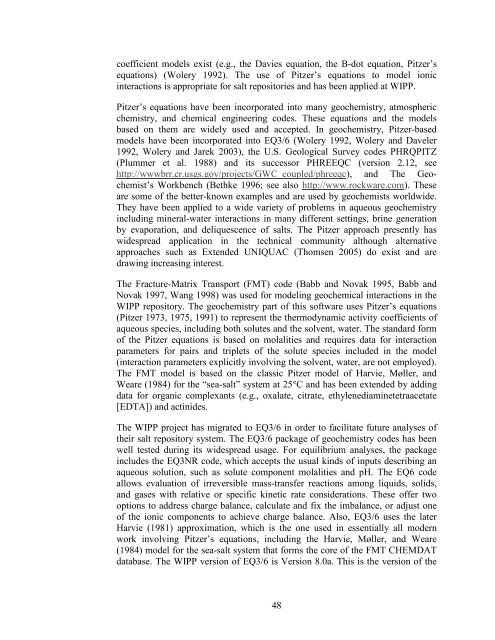Salt Disposal of Heat-Generating Nuclear Waste
Salt Disposal of Heat-Generating Nuclear Waste
Salt Disposal of Heat-Generating Nuclear Waste
You also want an ePaper? Increase the reach of your titles
YUMPU automatically turns print PDFs into web optimized ePapers that Google loves.
coefficient models exist (e.g., the Davies equation, the B-dot equation, Pitzer’s<br />
equations) (Wolery 1992). The use <strong>of</strong> Pitzer’s equations to model ionic<br />
interactions is appropriate for salt repositories and has been applied at WIPP.<br />
Pitzer’s equations have been incorporated into many geochemistry, atmospheric<br />
chemistry, and chemical engineering codes. These equations and the models<br />
based on them are widely used and accepted. In geochemistry, Pitzer-based<br />
models have been incorporated into EQ3/6 (Wolery 1992, Wolery and Daveler<br />
1992, Wolery and Jarek 2003), the U.S. Geological Survey codes PHRQPITZ<br />
(Plummer et al. 1988) and its successor PHREEQC (version 2.12, see<br />
http://wwwbrr.cr.usgs.gov/projects/GWC_coupled/phreeqc), and The Geochemist’s<br />
Workbench (Bethke 1996; see also http://www.rockware.com). These<br />
are some <strong>of</strong> the better-known examples and are used by geochemists worldwide.<br />
They have been applied to a wide variety <strong>of</strong> problems in aqueous geochemistry<br />
including mineral-water interactions in many different settings, brine generation<br />
by evaporation, and deliquescence <strong>of</strong> salts. The Pitzer approach presently has<br />
widespread application in the technical community although alternative<br />
approaches such as Extended UNIQUAC (Thomsen 2005) do exist and are<br />
drawing increasing interest.<br />
The Fracture-Matrix Transport (FMT) code (Babb and Novak 1995, Babb and<br />
Novak 1997, Wang 1998) was used for modeling geochemical interactions in the<br />
WIPP repository. The geochemistry part <strong>of</strong> this s<strong>of</strong>tware uses Pitzer’s equations<br />
(Pitzer 1973, 1975, 1991) to represent the thermodynamic activity coefficients <strong>of</strong><br />
aqueous species, including both solutes and the solvent, water. The standard form<br />
<strong>of</strong> the Pitzer equations is based on molalities and requires data for interaction<br />
parameters for pairs and triplets <strong>of</strong> the solute species included in the model<br />
(interaction parameters explicitly involving the solvent, water, are not employed).<br />
The FMT model is based on the classic Pitzer model <strong>of</strong> Harvie, Møller, and<br />
Weare (1984) for the “sea-salt” system at 25°C and has been extended by adding<br />
data for organic complexants (e.g., oxalate, citrate, ethylenediaminetetraacetate<br />
[EDTA]) and actinides.<br />
The WIPP project has migrated to EQ3/6 in order to facilitate future analyses <strong>of</strong><br />
their salt repository system. The EQ3/6 package <strong>of</strong> geochemistry codes has been<br />
well tested during its widespread usage. For equilibrium analyses, the package<br />
includes the EQ3NR code, which accepts the usual kinds <strong>of</strong> inputs describing an<br />
aqueous solution, such as solute component molalities and pH. The EQ6 code<br />
allows evaluation <strong>of</strong> irreversible mass-transfer reactions among liquids, solids,<br />
and gases with relative or specific kinetic rate considerations. These <strong>of</strong>fer two<br />
options to address charge balance, calculate and fix the imbalance, or adjust one<br />
<strong>of</strong> the ionic components to achieve charge balance. Also, EQ3/6 uses the later<br />
Harvie (1981) approximation, which is the one used in essentially all modern<br />
work involving Pitzer’s equations, including the Harvie, Møller, and Weare<br />
(1984) model for the sea-salt system that forms the core <strong>of</strong> the FMT CHEMDAT<br />
database. The WIPP version <strong>of</strong> EQ3/6 is Version 8.0a. This is the version <strong>of</strong> the<br />
48
















